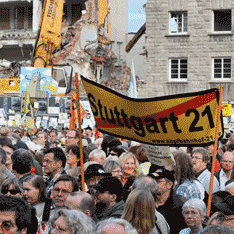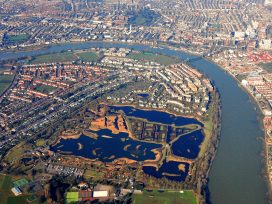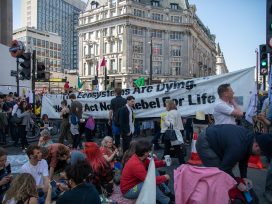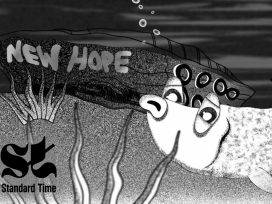 Two-hundred-and-fifty km/h from Stuttgart main station across the Schwäbische Alb – that’s what Baden-Württemburg’s political establishment have been dreaming about since 1994. Yet it’s not certain that Stuttgart’s railway terminus really will have been converted into an underground through-station by 2019. Public ire at Stuttgart 21 is growing and construction costs have exploded in the last few years. Estimated at 4.8 billion deutschmarks in 1995, a calculation in December 2009 put the cost at 4.1 billion euros. Then there is the additional 2.9 billion euros for the 60 km high-speed stretch between Wendlingen and Ulm, an essential component of Stuttgart 21.
Two-hundred-and-fifty km/h from Stuttgart main station across the Schwäbische Alb – that’s what Baden-Württemburg’s political establishment have been dreaming about since 1994. Yet it’s not certain that Stuttgart’s railway terminus really will have been converted into an underground through-station by 2019. Public ire at Stuttgart 21 is growing and construction costs have exploded in the last few years. Estimated at 4.8 billion deutschmarks in 1995, a calculation in December 2009 put the cost at 4.1 billion euros. Then there is the additional 2.9 billion euros for the 60 km high-speed stretch between Wendlingen and Ulm, an essential component of Stuttgart 21.
A look behind the scenes of one of the most costly infrastructure projects in Europe reveals why the debate has received attention beyond the region. Munich and Frankfurt stations had also been part of Deutsche Bahn’s plans for Project 21. There too, the idea was to move the platforms underground, thus freeing up attractive downtown real estate for sale via DB Services Immobilien GmbH. The project was scrapped both in the Bavarian capital as well as in Hessen’s financial metropolis because of the exorbitant costs. In July 2007, however, Stuttgart 21 was given the political blessing at the local, regional and federal levels.
Those who support the conversion of the 16-platform terminus into an 8-platform through-station refer enthusiastically to the reductions in travel time it would bring. Stuttgart 21 and the construction of the high-speed intercity stretch between Wendlingen and Ulm would shorten the journey to Munich main station by 26 minutes. Yet this calculation fails to mention that in 1995 – when the tracks were still regularly maintained and modernized – trains travelling from Stuttgart to Munich could cover the distance in 2 hours and 1 minute. Today, they need 2 hours and 20 minutes.
Moreover, freight transport is in danger of ending up on the sidings. On the steeper ascents, the new route is only suitable for goods trains with a maximum weight of 1000 tonnes and a length of 500 metres. Such trains barely run anymore, however: even ones used in “combined transport”, which are significantly lighter than freight-only trains, weigh on average a total of 1400 tonnes, and will continue to get heavier. Supporters of Stuttgart 21 call it a central limb of the “Magistrale for Europe” between Paris and Budapest. Yet why isn’t the acceleration of rail transport through improvements to interoperability backed with the same passion? In Europe there are still three different gauge-widths, fifteen different automatic train control systems and six different electricity systems.
Misguided rail policy
Talk is now of “Merkel’s mess”, while the political future of Baden-Württemberg’s Minister President, Stefan Mappus (Christian Democratic Union), depends on the project being seen through. This goes to show how Stuttgart 21 is seen by many as a symbol of the failure of rail policy at the federal level. Although around 90 per cent of all train journeys are made on local rail, i.e. routes of less than fifty km or journeys lasting under an hour, it attracts only 10 per cent of all transport-related investments. Nine out of 10 euros are invested in the development of long-distance travel – despite stagnating passenger revenue.
The “hub and spoke” strategy, whereby maximum speed is raised not across the route as a whole but over particular stretches, is of no avail. All too often, travelling time made up on high-speed stretches is lost because of poor connections with local networks. This, despite that fact that Germany’s polycentric urban structure seems predestined for a close-knit rail network able to catch “as many fish on the transport market as possible”. The back-down from blanket rail coverage accompanies the targeting of a specific clientele: business passengers who, as (potential) first-class customers, want WLAN connections and mobile telephone reception as well as exclusive service in the DB “lounges”. After the appointment of former DB managing director Hartmut Mehdorn in December 1996, the self-styled “company of the future” gave up on blanket rail coverage that democratizes fast travel for all, instead of monopolizing it for a small minority.
Freight transport also loses out from the market-oriented move away from blanket rail coverage. Politicians from all parties have been declaring their intention to move freight transport from the roads onto the tracks for decades, yet since 1992 the number of industrial rail connections has been cut by over two-thirds. The Rhine Valley stretch is the most important German freight connection between the Baltic and the Mediterranean. Yet because it has only two rather than four tracks, it still creates a bottleneck for European freight transport. Investment delays resulting from the horrendous expenses caused by large-scale projects such as Stuttgart 21 or new lines such as the inter-city stretch between Nuremberg, Erfurt and Halle, or Wendlingen and Ulm, need to be made up for in full. Otherwise, freight transport will continue to be transferred to the motorways, despite lorry tolls, eco-tax and rising fuel prices.
The aim to get railways to take on a larger share of transport needs to be pursued not via a few supposedly prestigious large-scale projects, but through intelligent networking of local and long-distance transport, greater frequency of trains and increased coverage. Only then can rail policy be successful. An example might be the Swiss national railway system, where the time-honoured rule of transport science – “Supply creates demand” – has been rigorously applied. After a popular referendum in 1987, trains were modernized, rail bottlenecks relieved and the various sub-systems of public transport linked up more closely still. The Swiss rail system is the most heavily-used in Europe, yet 95 per cent of trains arrive with variations to the timetable no greater than four minutes. In Germany, that would only be possible if the locomotives were maintained more frequently, if platforms were improved on an ongoing basis, and if the “segregation” of passenger and freight transport was made a priority.
Market compatibility as leitmotif
Like the construction of Berlin’s 1.1 billion euro main station, Stuttgart 21 is the expression of a new railway-station culture. The capitalization of the German railways results in train stations forfeiting their character as public spaces and cultural monuments; new designs transform what were once everyman’s “entrance to the city” into “shopping worlds with rail access” patrolled by private security firms. The symbolic value and emotional significance railway stations have for the rail system as a whole cannot be overestimated. If the facades of station buildings begin to crumble, if platforms are riddled with holes and if poorly-lit underpasses stink of urine, then even the most enthusiastic train passenger is put off. It can only be hoped that the 300 million euros that DB has received via the stimulus package will indeed flow into the modernization of small and medium-sized stations.
The goal of capital market compatibility firmly in its sights, DB is forging ahead with the sale of station buildings and the break-up of assets, thus increasing its returns. Between 1994 and 2006, more than 1200 station buildings were sold and several hundred closed; in the mid to long term, a further 1800 of the remaining 2400 concourse-style stations are earmarked for sale and/or closure. The idea is that platforms, ticket machines and waiting rooms are all that need to be retained, meaning that the erstwhile emblems of cities and communities will continue to lose their significance. The density of stations has already sunk drastically: in the 1960s, the average distance between stations in West Germany was 4.1 kilometres; today, there is a station only every seven kilometres – on a railway network that has shrunk by a third since 1994.
Uproar in Stuttgart
The protests against Stuttgart 21, which have grown out of the “Monday demonstrations” held since November 2009, have long since ceased to be directed only against the “speedway in the sticks”. “Water canons, truncheons and pepper spray has served only to drive even more people onto the barricades” commented the Speigel recently.
Feeling their sense of democracy violated, Stuttgarters have been demonstrating in their thousands. They have had to watch the civic come to nothing and citizens’ participation turn into a farce. The “Association against Stuttgart 21” has been able to collect over 61 000 valid signatures, despite the fact that a third of that would have been enough to successfully call a referendum. Yet the Stuttgart city council rejected the application on legal grounds by 45 votes to 15. This angered many residents: Stuttgart’s mayor at the time, Wolfgang Schuster (Christian Democratic Union) had declared his intention to back a referendum if the city of Stuttgart were to claim “significant extra expenditure” for the alleged “prestige project” – which is what has happened.
The Swabians have now lost trust in political rhetoric claiming that Stuttgart 21 is an “essential” modernization project whose failure would impair the “future capacity” of the state. They are not prepared to accept that Germany’s last big public company, which receives billions of taxpayers’ money annually, engages in politics that run counter to the interests of the majority.
Grassroots not trading floor
Stations, platforms and railway track must (continue) to be modernized: there is no question about that. However it shouldn’t be necessary to overhaul entire city-centres, which is what will happen with Stuttgart 21, nor to pursue large-scale projects such as this at the expense of small and medium-sized stations. Railway passengers in Siegen, Sigmaringen and Soet are also entitled to well-maintained stations – and attractive access to local networks and decent long-distance connections.
This ideal, however, clashes with the investment policy of what was once Germany’s largest employer. As a company PR brochure puts it: “The world of DB plc not only gets bigger every year, it also turns faster”. Indeed, during the “Mehdorn era”, numerous acquisitions were made which were extraneous the core business of domestic rail travel. For example, the company invested in road-haulage companies both in Germany and abroad (e.g. Schenker, Hangartner and Joyau), the British freight railway EWS, the US air-and-sea freight specialists Bax Global, the Danish bus company Pan Bus, and the English regional rail operator Chiltern Railways.
Deutsche Bahn’s current CEO, Rudiger Grube, who, like his predecessor, began his professional career in the automobile branch, has also internationalized the company: in August 2010 DB took over the British transport company Arriva for the grand sum of 2.8 billion euros. That it was possible make these acquisitions with the backing of the German state evinced justified criticism, given that in Germany there are currently 48 rail projects categorized as necessary in terms of transport yet impossible to finance. Protests against the investment and expansion policy of Germany’s last big state-owned company is likely, therefore, to articulate itself not only in the capital city of Baden-Württemberg, but across the whole country – the first indications of this are already showing. After all, the billions of euros either wasted in Stuttgart or invested in London and Zürich are missing elsewhere. The consequences will be fatal for rail travel in Germany.

 Two-hundred-and-fifty km/h from Stuttgart main station across the Schwäbische Alb – that’s what Baden-Württemburg’s political establishment have been dreaming about since 1994. Yet it’s not certain that Stuttgart’s railway terminus really will have been converted into an underground through-station by 2019. Public ire at Stuttgart 21 is growing and construction costs have exploded in the last few years. Estimated at 4.8 billion deutschmarks in 1995, a calculation in December 2009 put the cost at 4.1 billion euros.
Two-hundred-and-fifty km/h from Stuttgart main station across the Schwäbische Alb – that’s what Baden-Württemburg’s political establishment have been dreaming about since 1994. Yet it’s not certain that Stuttgart’s railway terminus really will have been converted into an underground through-station by 2019. Public ire at Stuttgart 21 is growing and construction costs have exploded in the last few years. Estimated at 4.8 billion deutschmarks in 1995, a calculation in December 2009 put the cost at 4.1 billion euros.




